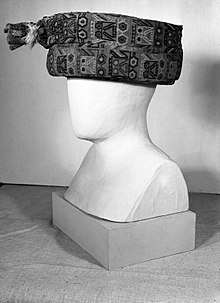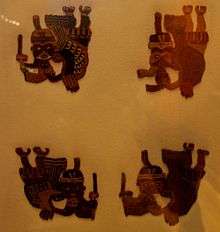Paracas culture
The Paracas culture was an Andean society existing between approximately 800 BCE and 100 BCE, with an extensive knowledge of irrigation and water management and that made significant contributions in the textile arts. It was located in what today is the Ica Region of Peru. Most information about the lives of the Paracas people comes from excavations at the large seaside Paracas site on the Paracas Peninsula, first investigated by the Peruvian archaeologist, Julio Tello, in the 1920s.
The Paracas Cavernas are shaft tombs set into the top of Cerro Colorado, each containing multiple burials. There is evidence that over the centuries when the culture thrived, these tombs were reused. In some cases, the heads of the deceased were taken out, apparently for rituals, and later reburied. The associated ceramics include incised polychrome, "negative" resist decoration, and other wares of the Paracas tradition. The associated textiles include many complex weave structures as well as elaborate plaiting and knotting techniques.
The necropolis of Wari Kayan consisted of two clusters of hundreds of burials set closely together inside and around abandoned buildings on the steep north slope of Cerro Colorado. The associated ceramics are very fine plain wares, some with white and red slips, others with pattern-burnished decoration, and other wares of the Topara tradition. Each burial consisted of a conical textile-wrapped bundle, most containing a seated individual facing north across the bay of Paracas, next to offerings such as ceramics, foodstuffs, baskets, and weapons. Each body was bound with cord to hold it in a seated position, before being wrapped in many layers of intricate, ornate, and finely woven textiles. Now the Paracas Necropolis embroideries are known as some of the finest ever produced by Pre-Columbian Andean societies and are the primary works of art by which Paracas culture is known. Burials at the necropolis of Wari Kayan continued until approximately 250 CE, and many of the mortuary bundles include textiles similar to those of early Nazca.

Topara
While the Paracas culture developed in this region between approximately 1200 BCE and 100 BCE, the Topará culture is thought to have "invaded" from the north at approximately 150 BCE. The two cultures then coexisted for one or more generations, both on the Paracas Peninsula and in the nearby Ica Valley, and their interaction played a key role in the development of the Nazca culture and its ceramic and textile traditions. Although the elaborate textiles have been preserved in only the coastal desert sites, there is growing evidence that people associated with these cultures lived and traveled among the Pacific lowlands, the Andean highland valleys, and mountain pastures to the east.

Paracas geoglyphs
In 2018 drones used by archaeologists revealed many geoglyphs in the Palpa province that are being assigned to the Paracas culture. Many predate the associated Nasca lines by a thousand years and some demonstrate a significant difference in the subjects and locations, such as some being on hillsides.[1] Research on the geoglyphs is in progress.
See also
References
- ↑ Greshko, Michael, Exclusive: Massive Ancient Drawings Found in Peruvian Desert, National Geographic, April 5, 2018
- Paracas Art and Architecture: Object and Context in South Coastal Peru by Anne Paul, Publisher: University Of Iowa Press, 1991 ISBN 0-87745-327-6
- Ancient Peruvian Textiles by Ferdinand Anton, Publisher: Thames & Hudson, 1987, ISBN 0-500-01402-7
- Textile art of Peru by Jose Antoni Lavalle, Publisher: Textil Piura in the Textile (January 1, 1989), ASIN: B0021VU4DO
External links
| Wikimedia Commons has media related to Cultura Paracas. |
- CIOA Field Report of a Paracas-period Site
- Paracas Textiles at the Brooklyn Museum
- Gallery of Paracas objects (archived link, text in Spanish)
- Impacts on Tourism at Paracas (in Spanish)
- Precolumbian textiles at MNAAHP (in Spanish)
- Paracas textile at the British Museum
- Ancient Peruvian ceramics: the Nathan Cummings collection by Alan R. Sawyer, an exhibition catalog from The Metropolitan Museum of Art (fully available online as PDF), which contains material on Paracas culture (see index)